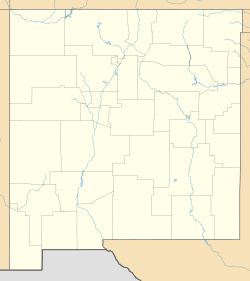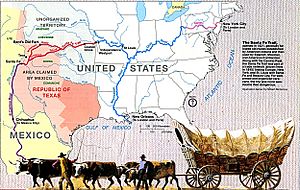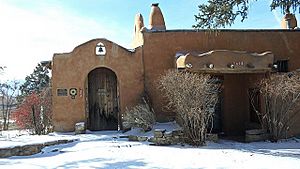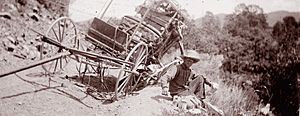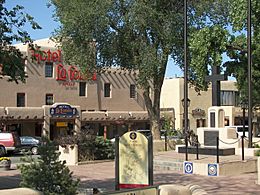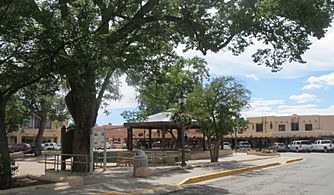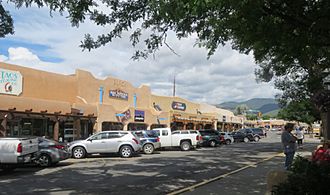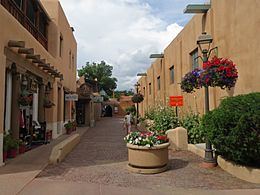Taos Downtown Historic District facts for kids
|
Taos Downtown Historic District
|
|
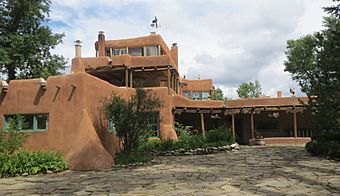
|
|
| Location | NM 3 and NM 240, Taos, New Mexico |
|---|---|
| Area | 30 acres (12 ha) |
| Architect | multiple |
| Architectural style | Late 19th And 20th Century Revivals, Colonial |
| NRHP reference No. | 82003340 |
Quick facts for kids Significant dates |
|
| Added to NRHP | July 8, 1982 |
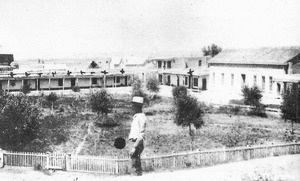
The Taos Downtown Historic District is a special area in Taos, New Mexico, known for its history. Taos was very important in the growth of New Mexico. It played a big part under the rule of the Spanish, Mexicans, and Americans. This historic district is also a key stop on the Enchanted Circle Scenic Byway in northern New Mexico.
Contents
Discovering Taos: Location and Landscape
The Taos Downtown Historic District is right in the middle of Taos, New Mexico. Its main boundaries are Ojitos, Quesnel, Martyer's, La Placacitas, and Ranchitos Streets.
The wider area, once called Don Fernando de Taos, sits in the Taos Valley. It is next to Taos Creek and about 2 miles (3.2 km) south of Taos Pueblo. In the distance, you can see Taos Peak.
Taos Through Time: A Rich History
Early People: Native Americans in Taos
Long ago, about 6,000 years back, Native Americans lived and traveled through the Taos area. We know this from Arrowheads, broken pottery pieces (called potshards), and pictographs found here. Around 900 years ago, Pueblo people made their homes in the Taos Pueblo and Picuris Pueblo areas.
Spanish Arrival and Settlement
In 1540, Spanish explorers, led by Hernando de Alvardo, first came to the Taos Valley. Spanish settlers began to live here around 1615. At first, the Pueblo people and the settlers got along well. But soon, things became difficult. Spanish missionaries treated the Pueblo residents poorly, pushing them to change their religion. They also demanded payments from them.
Some settlers left Taos in 1640 after a priest was killed. In 1661, some returned, but the situation was still hard. Because of the unfair treatment, the Pueblo Revolt happened in 1680. Native peoples fought back and forced the Spanish out of the area. Sixteen years later, Don Diego de Vargas from Spain resettled the Taos valley. This time, he came with a more respectful approach. Spanish families settled around the Taos Plaza and in Ranchos de Taos. By 1710, Spain had full control of the territory again.
To stay safe from attacks by Plains Indians, many Spanish people lived very close to the Taos Pueblo. Later, the Spanish were asked to move at least "one league" (about 3 miles) away. This was because there was a lot of marriage between Spanish and Pueblo people.
In 1779, Juan Bautista de Anza led the Battle of Cuerno Verde against the Comanches. Several tribal leaders, including their chief, were killed. After this battle, attacks from that tribe became less frequent. In 1794, a rule was made that stopped Spanish, and people of African or mixed heritage from living on Pueblo lands. Also, new rules from Commandant General Teodoro de Croix helped reduce hostile attacks in the Taos Valley.
In 1796, the Don Fernando de Taos Land Grant gave land to 63 Spanish families in the Taos valley. This included the Taos Plaza, which was then called Don Fernando de Taos. The settlement was built like a strong fort, with thick adobe walls and gates. This protected the people and their animals from attacks by Plains Indians. Guards stood at each corner of the plaza walls. Inside the plaza, people celebrated holidays, attended church events, and traded goods. Today, it is a central plaza surrounded by homes.
Taos was the most northern point on the El Camino Real de Tierra Adentro. This important road, also known as the King's Highway, stretched all the way from Mexico City.
In the early 1800s, mountain men who trapped for beaver made Taos their home. In December 1826, Kit Carson arrived. He later married Josefa Jaramillo from Taos. At that time, about 500 settlers lived in Taos. It was almost as important as Santa Fe. It was the northernmost customs office for the Spanish settlements.
As the Santa Fe Trail opened between Missouri and Santa Fe, trade in furs and other goods grew in Taos. People of American, Spanish, and Native American backgrounds all took part. Famous traders like Charles Bent and William Bent ran Bent's Fort. Goods from Taos included furs, blankets, and a strong drink called "Taos lightning."
In 1826, Padre Antonio José Martínez began serving the church of Our Lady of Guadalupe. He also started a newspaper, the first one west of the Mississippi River. This newspaper was the start of today's The Taos News.
By 1830, a building for a jail and courthouse was built on the north side of the plaza. Hotels, saloons, and gambling places were also built. These helped welcome the many visitors coming to Taos.
- Historic Places to Visit
Becoming American Territory
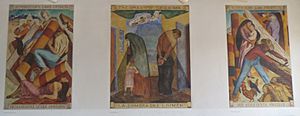
The United States took control of New Mexico in 1847 during the Mexican–American War. In response, some former Mexican citizens and Taos Natives rebelled. This event was called the Taos Revolt. During the revolt, Charles Bent, the first governor of the New Mexico territory, was killed in his home. The United States Army responded by killing over 150 people at the Taos Pueblo. They also destroyed the original San Geronimo Mission. In 1850, New Mexico and Arizona officially became a territory of the United States.
Taos is one of the oldest Spanish settlements in the Taos valley. You can see many different building styles here. These include Spanish Colonial, Mission Revival, Pueblo Revival, and Territorial architecture.
In 1930, a fire damaged several buildings on the plaza. This included the courthouse and the Don Fernando Hotel. A new courthouse was built. In 1933 and 1934, the Works Progress Administration (WPA) paid for new murals inside the courthouse. These beautiful paintings were made by artists from the Taos art colony. They included Emil Bisttram, Victor Higgins, Ward Lockwood, and Bert Geer Phillips.
- More Historic Sites
The Taos Art Colony: A Creative Hub
In the late 1800s, many artists came to live and work in Taos. They formed the Taos art colony. The first artists to arrive were Bert Geer Phillips and Ernest L. Blumenschein in 1898. They were amazed by the beautiful scenery and clear light in Taos. In 1912, they and other artists who had moved to Taos formed the Taos Society of Artists.
In 1917, a famous socialite named Mabel Dodge Luhan came to Taos. She invited many creative and famous people to the area. These included Carl Jung, Georgia O'Keeffe, D. H. Lawrence, Thomas Wolfe, Willa Cather, Ansel Adams, Thornton Wilder, and Aldous Huxley.
- Art-Related Sites
- Ernest L. Blumenschein House
- Eanger Irving Couse House and Studio—Joseph Henry Sharp Studios
- Nicolai Fechin House
- Leon Gaspard House
- Harwood House
- Ernest Martin Hennings
- Mabel Dodge Luhan House
- Taos Art Museum
The Hippie Era in Taos
Inspired by the movie Easy Rider, many Hippies came to Taos in the 1960s and 1970s. Their presence brought new ideas and influenced the culture of Taos.
Taos Historic Places Map
 |
Governor Charles Bent House, Taos Inn, The Bernard Beimer House, Taos Art Museum, the Nicolai Fechin House, Taos Pueblo | Mabel Dodge Luhan House, La Morada de Nuestra Senora de Guadalupe |  |
|
| Our Lady of Guadalupe Parish (Taos, New Mexico) | Kit Carson House, Eanger Irving Couse House and Studio—Joseph Henry Sharp Studios, Ernest Martin Hennings House, the Leon Gaspard House | |||
Taos Downtown Historic District |
||||
| La Loma Plaza Historic District | Ernest L. Blumenschein House, Harwood House |
Gallery
-
Taos Plaza and La Fonda Hotel. Part of the hotel was once the store of Charles Bent and Ceran St. Vrain.


